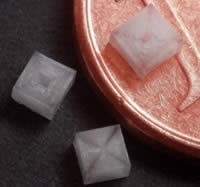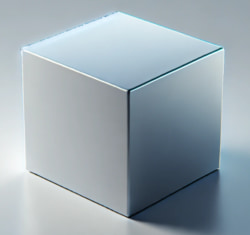Cube
A box-shaped 3D object with six identical square faces.
Go to Surface Area or Volume
Cube Facts
Notice these interesting things:
- It has 6 faces
- It has 12 edges
- It has 8 vertices (corner points)
- Each face has 4 edges (and is a square )
- At each vertex 3 edges meet
- It is one of the Platonic Solids
images/polyhedra.js?mode=cube
A cube is also a regular hexahedron, from the Greek 'hexa-' meaning 6, because it is a polyhedron with 6 faces.
Cubes make great 6-sided dice because they are regular in shape, and each face is the same size.
In fact we can make fair dice using all of the Platonic Solids.
| Make your own Cube: cut out the shape and glue it together. |

Salt crystals naturally grow in cube-like shapes,
because the atoms link up as corners of a cube.
Surface Area
The surface area of a cube is the total area of all six square faces:
Surface Area = 6 × (Edge Length)2
Example: Edge Length = 4
Surface Area= 6 × (Edge Length)2= 6 × 42= 6 × 16= 96
Volume
Volume = (Edge Length)3
Example: Edge Length = 4
Volume= (Edge Length)3= 43= 4 × 4 × 4= 64

Example: this cube is 0.5 meters on each side, what is its volume?
Ignoring the slight rounding on edges:
Volume= (Edge Length)3= (0.5 m)3= 0.5 m × 0.5 m × 0.5 m= 0.125 m3
Since 1 m3 equals 1000 liters this is also equal to 125 liters.
855, 856, 857, 858, 1822, 1823, 1835, 1836, 1837, 1838